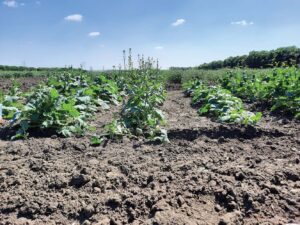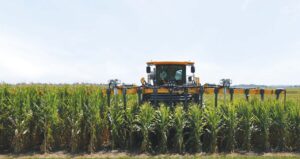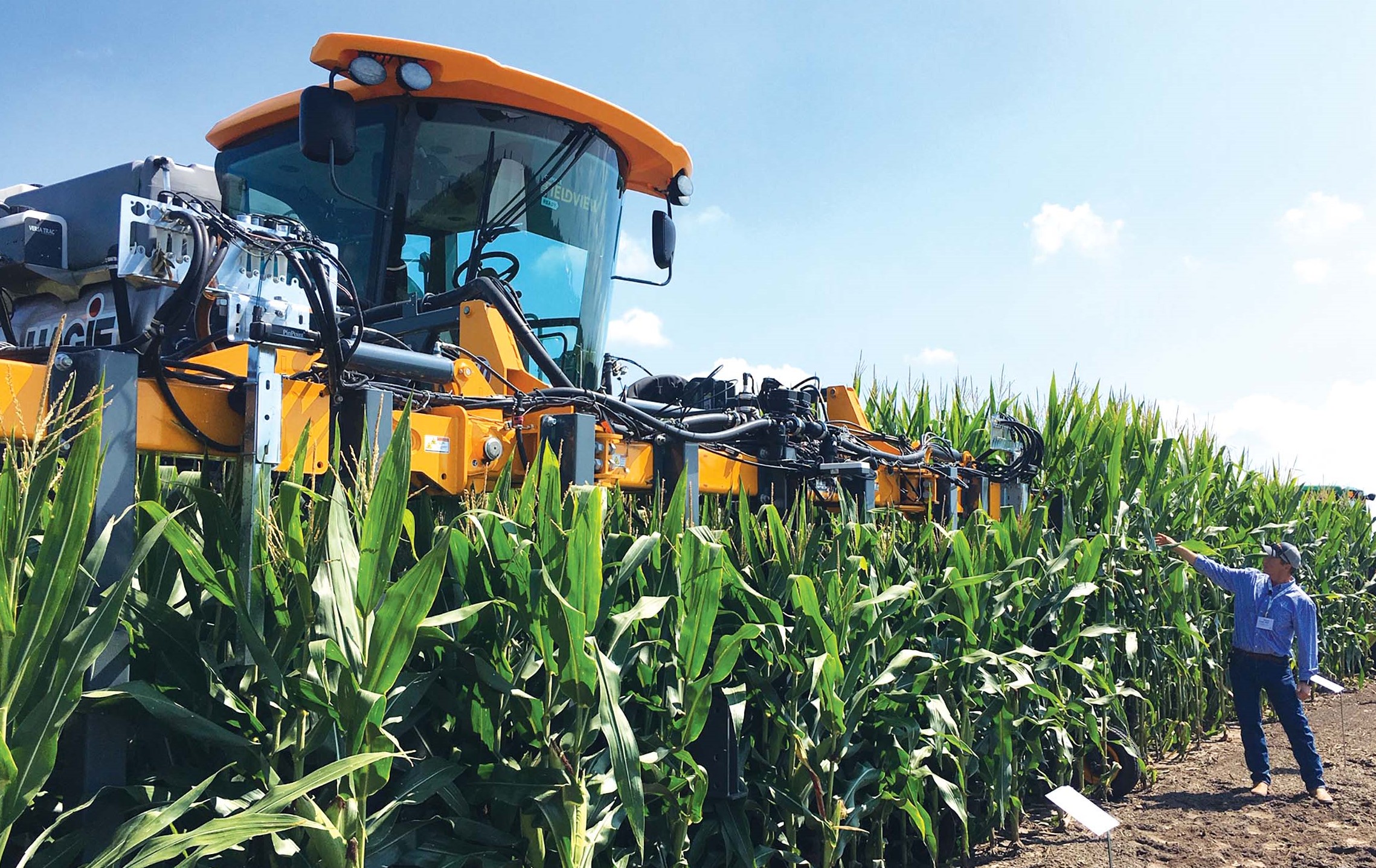Morphing Canola
With increasing challenges around severe storms, farmers are experiencing more downed corn. Short corn is three feet shorter but has the same leaf area and yield potential of normal tall corn. With a lower centre of gravity and stronger stalk resistance, short corn will have greater stability in these storms. It should also stay standing and yield more when given higher levels of fertilizer.
Photo: Bayer
At the World Agri-Tech Innovation Summit in California in March, top representatives from at least two corn seed companies – Corteva and Bayer – mentioned their plans to launch short stature hybrids – shaving about three feet off the giant grass.
Breeders are working on hybrids five to seven feet tall with the same leaf area but less length between stem nodes than the standard 10-footers. This will “de-risk standability – the biggest issue in corn breeding,” says Wendy Srnic, vice president with Corteva Agriscience’s research and development team. Keeping corn from falling over has limited breeding for higher yield. “We see short corn as not just a niche product. It could become the new normal for corn.”
Corteva has been working on short stature corn for a long time, beginning at both of its heritage companies, Dow Agrosciences and Pioneer Hi-Bred.
Bayer started its short corn program in 2007 and calls it a “game changer.” Denise Bouvrette is Bayer’s North American strategy and launch lead for its Preceon short corn system. With increasing challenges around weather, specifically the “severity and frequency of storms,” farmers are experiencing more downed crop, Bouvrette says. Corn with a lower centre of gravity and stronger stalk resistance will reduce risk and hopefully increase profitability.
The Bayer program has two pathways – traditional breeding to develop corn with brachytic 2 gene, a native trait, and a biotech version co-developed with BASF. The native trait relies on the hormone auxin to tighten internode spacing below the ear. The biotech trait relies on the hormone gibberellic acid for shorter internode spacing top to bottom. “The biotech trait results in more consistent spacing,” Bouvrette says.
Bayer will have a small commercial introduction of its traditional-bred short corn in the U.S. in 2024 and estimates the biotech version will launch late this decade. Corteva estimates a mid-decade launch.
Besides standability, short corn also allows for season-long access to the crop with ground-applied equipment. “You can drive across the crop with a standard height sprayer and can see where you’re driving,” Bouvrette says. “Booms aren’t snapping and bending stalks.” This will make it possible, or at least easier, to apply a nitrogen side-dress and fungicides later in the season.
Kevin Kosola led a collaborative study to compare experimental short hybrids to tall corn hybrids in Illinois and Indiana from 2017 to 2019. Kosola and coauthors published the results in Field Crops Research in 2023, noting that while total nitrogen uptake at maturity was not different between short-stature hybrids and their tall counterparts, the plants partitioned that nitrogen in different ways. Short corn had less nitrogen in the stalk than tall corn. At flowering specifically, short corn had more nitrogen in its leaves than tall corn did and short corn averaged 18 per cent more dry matter and nitrogen accumulation in its ears. Harvest index – pounds of grain divided by total pounds of above-ground biomass (grain plus stover) – was slightly better for the short corn. These features could potentially be exploited in breeding programs for higher yield, the Kosola paper concludes.
Bayer and Corteva are making that bet. “It has taken time to produce hybrids with all the right features, including keeping ear height at 24 inches so farmer can still harvest it with standard equipment,” Bouvrette says. “The level of development was like creating a new crop from scratch.”
This is part of a continuous improvement in corn design. “In the 1950s, corn was taller with longer, droopier leaves, and the recommendation was for more spacing between plants,” Srnic says. “Now, density is up because breeders have selected for plants that thrive in higher density. Leaves are upright and broader, like solar panels that optimize exposure to the sun.”
Short corn maintains that leaf area, and puts more nitrogen into the leaf and ear, and less into stems. The result should be a more efficient and more climate resilient crop.
How do we do the same for canola?
A hotter and drier climate on the Canadian Prairies is not favourable to a cool season crop like canola. A canola plant that uses water more efficiently, that pollinates and produces seed under higher heat and that converts sunlight into higher yield would help the crop adapt to these conditions. Advanced solutions will come through gene editing and transgenics. Priorities for climate adaptation of canola plants are water use efficiency, heat-tolerant pollination and reproduction, and enhanced photosynthesis.
Water use efficiency. We don’t want canola to suck up every available drop of water from the soil because it doesn’t set up well for the following crop. Instead, we want the plant to be more efficient at turning the resources it has into yield.

Osmotic adjustment. Drought-resilient plants have an ability to adjust the amount of water they store in their cells. In dry conditions, cells within these plants will increase salt molecules to draw in water and store it. This “osmotic adjustment” reduces the water lost through evapotranspiration, allowing plants to survive longer during a drought. Brassica juncea and Brassica rapa have this feature. Brassica napus, the common canola species, does not. “Napus blows through water like no tomorrow,” says Rob Gulden, plant science researcher and professor at the University of Manitoba. Breeding napus with the osmotic adjustment of its brassica cousins could make for hybrids somewhat more resilient in drought-prone areas of the Prairies.
Rooting efficiency. Isobel Parkin, research scientist with Agriculture and Agri-Food Canada (AAFC) in Saskatoon, has a new project to screen diverse brassica germplasm for suitable variations in root architecture. It will then put the most suitable traits into Brassica napus trial lines for more advanced breeding and analysis. One objective is to assess root traits for improved water use efficiency, with the goal to increase yields while reducing further use of limited resources, namely water, and fertilizer inputs.
Drought tolerance is regulated by a complex network of several molecular, physiological and structural factors. These genes, however, can be grouped. “Looking further down the road, a superfamily of genes has been identified that may be key to unlocking disturbance of water stress on leaves, stems and roots, thereby preventing yield loss,” says Curtis Rempel, vice president, crop production and innovation, with the Canola Council of Canada. “This gene superfamily may also play a role in increasing rooting depth, which would also impact nitrogen use efficiency and sequester more carbon deep in the soil.”
Heat-tolerant reproduction. Heat stress during flowering disrupts the pollination, or fertilization, process within canola flowers. Pods and seeds don’t form and yield drops. AAFC studies show yield drop starts with temperatures over 29.5°C at flowering. However, not all canola cultivars are the same. Researchers Chad Koscielny, then at the University of Manitoba, and Malcolm Morrison at AAFC, in separate studies, showed notable differences in heat stress tolerance among canola cultivars. Koscielny, North American canola breeding lead at Corteva Agriscience, says Corteva, which owns the Pioneer Hi-Bred and Brevant brands, continues to work on heat stress in its canola breeding program. Researchers around the world are also looking into this. “There has yet to be any simple solutions discovered,” Koscielny says. In Australia, Sheng Chen at the University of Western Australia leads a project to identify heat tolerance genes in canola. GRDC funds the project and, as written in a GRDC article, Chen has identified 334 candidate genes related to heat tolerance. The article quotes Chen saying individual genes seem to have minor effects on their own and will need to be combined to show any significant advancement.
“A longer term approach to improving drought tolerance and increasing overall yields is to change the photosynthetic capacity of canola. This means changing canola from a C3 plant to a C4 plant, the equivalent of rapidly changing millions of years of evolution.”
— Curtis Rempel
Enhanced photosynthesis. Improving the efficiency of photosynthesis at the biochemical level is a global effort. Rempel says one pathway for canola, a C3 plant, is to use transgenics to make it a C4 plant. Corn is a C4 plant. These labels describe the number of carbons in the molecules produced through the photosynthetic process, and C4 plants are considered more efficient at converting sunlight. “When canola is under heat or moisture stress, photosynthetic rates drop dramatically, as does pollen viability,” Rempel says. This reduces number of pods, number and size of seeds per pod and oil content per seed. “A longer term approach to improving drought tolerance and increasing overall yields is to change the photosynthetic capacity of canola,” Rempel says. “This means changing canola from a C3 plant to a C4 plant, the equivalent of rapidly changing millions of years of evolution.” Moricandia arvensis, a plant species originating in the Mediterranean, has been classified as a rare C3-C4 intermediate species, which Rempel says could be the bridge to transfer C4 photosynthesis to Brassica species.
Kevin Rozwadowski, research scientist at AAFC Saskatoon, is taking a different approach to photosynthesis. He has a new gene-editing project to improve photosynthesis efficiency through canola architecture adjustment. He is looking at two specific areas. One, to make the flowering area more compact to increase sunlight penetration to the leaves during flowering. Two, to change leaf area and angle of presentation so leaves intercept more sunlight. “Can we make these changes and improve yields? That is what we’re trying to find out,” Rozwadowski says.
These are not just public research efforts. Jeff Mansiere is North American canola breeding manager for BASF, Canada’s largest canola seed company. He says environmental stress tolerance is “definitely on our radar,” adding “canola performance under heat and drought stress is a big pressure point on the Prairies.”
He says the public work to scan the range of Brassica crops to identify target genes is useful. “For example, public canola research has identified five genes related to drought stress response. BASF can then look through its canola material to see if it has lines that contain those genes. If not, then it could turn to public geneticists for source material,” Mansiere says.
Climate-related targets for BASF include genes associated with early maturity and flowering timing to avoid peak heat. Mansiere also expects some structural change to the canola plant. The company is looking at short stature canola, particularly for European winter hybrids, and investigating traits to regulate stomata control, which would reduce the flow-through of water and make canola more water efficient.
The challenge from a commercial seed perspective, Mansiere says, “is if we develop a line with drought tolerance but that line doesn’t perform in good growing conditions, what good is it to the grower?”
These are complex traits. Genetic tools make it easier to identify the genes and move them into commercial lines, but we’re talking dozens, maybe hundreds, of genes. As breeders work to make canola more tolerant to heat stress and water shortages, advances in the short term are likely to show small incremental improvements, not major changes to the plant plumbing and architecture. “But the plant-morphing revolution is on the way thanks to new breeding technologies,” Rempel says.






